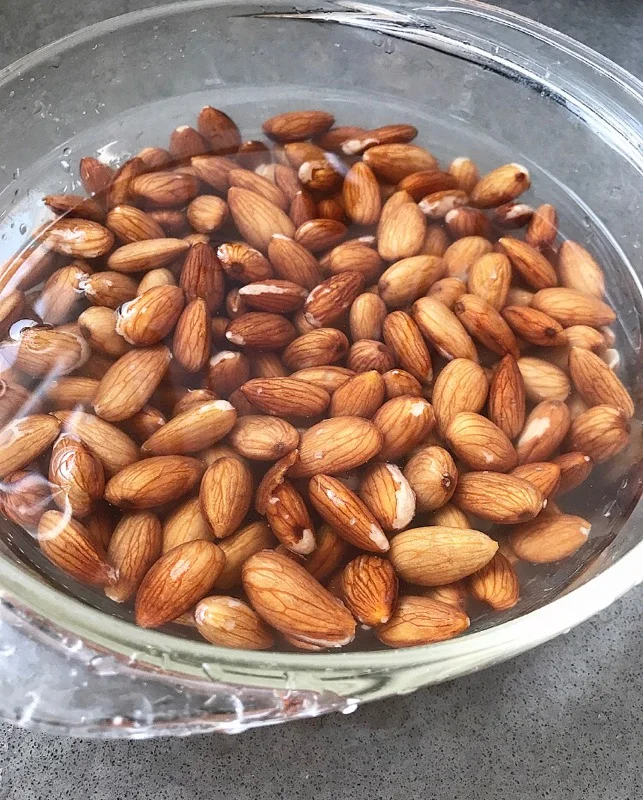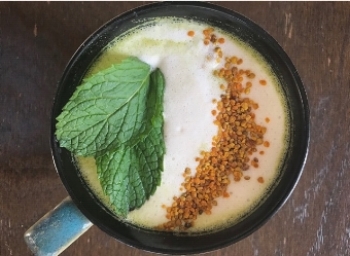Remember the days when soy milk seemed like the only alt mylk around? Oh, how things have changed! These days, most coffee shops offer multiple varieties of dairy-free mylks, and if you’re lucky, you can even find a local shop that makes its own nut mylks from scratch! I must admit, this has become my top priority when scouting out new cafes. Sometimes you just have to embrace your foodie ways. Hey, that rhymes!
And since my bank account is not a fan of spending upwards of $6 on a matcha latte made with in-house nut mylk on a super regular basis, I opt for homemade drinks most of the time. Also, let’s be real: I’m a huge fan of playing Alchemist in the kitchen. While nut mylks may be making a name for themselves out there in the real world, most baristas will look at you funny if you ask them to toss some adaptogenic herbs into the mix. Literally “doctoring” up my drinks always - just ask my people. So, it’s with a joyful and creative heart that I take you into my kitchen and teach you my nut-mylking ways.
Today’s ingredient of choice is the subtly sweet, increasingly versatile, often California-bred, much beloved almond. Besides being undeniably delicious, almonds are rich in protein, healthy monounsaturated fats, iron, calcium, phosphorous, potassium, magnesium, zinc, and Vitamin E. The list goes on. I was surprised to discover that almonds are also the only nuts that alkalize the blood, which is all the more important considering the increasingly acidic nature of the modern diet. According to Ayurvedic tradition, almonds foster our capacity for understanding, revive our spirituality, and bolster reproductive ability. From the perspective of Chinese Medicine, almonds have a predilection towards the Metal organ system. In other words, they impact the Lung and Large Intestine most dramatically. This is especially relevant as we begin to transition into Autumn, the season of the Metal element.
With a mildly warming and sweet nature, almonds aid in the relief of lung qi stagnation and moisten dryness in the large intestine. They can help to transform phlegm, alleviate cough, and “lube the tubes”. So, if you’re suffering from a cough, struggle with asthma accompanied by weakness/fatigue & white or clear phlegm, or constipation due to dryness (infrequent, small, hard stools), consider incorporating more almonds into your diet. However, not all almonds are created equal, and moderation is key as always. You should avoid excessive consumption of almonds in conditions of dampness (i.e., sluggishness, thick greasy tongue coating, edema), and pay close attention to the source of your almonds, as well as the state in which they’re consumed. Organic, raw, soaked or sprouted, and naked (the almonds, silly) is best! Let’s look at why...
Drinking the mylk of almonds is an especially nutritious, gut-friendly, and delicious way to benefit from the powers of these nuts. When you soak almonds (as well as other nuts, seeds, legumes), as you will in this recipe, you help to begin the breakdown of phytic acids, the storage form of phosphorus found in many plants, which inhibits many of the enzymes necessary for proper digestion, and interferes with our ability to absorb certain minerals present in the foods we eat.
Removing the skins is an even more effective way to avoid excessive phytic acid consumption, and prevent irritation of the gut lining. This step in the process has become a sort of meditation for me, gently slipping the skins away one-by-one and grinning with satisfaction as the slippery flesh underneath playfully pops into the bowl with a youthful pizzazz. Just as we transition out of our sun-kissed Summer bodies into the purity & twilight of Autumn, soaked almonds shed their skins to reveal the luminous ivory gem within. I like to keep some of the whole, soaked naked almonds aside for drying & snacking on later. Yum.
You’ll want to use raw organic almonds when making this mylk. Sounds simple enough, right? Wrong. “In response to outbreaks of Salmonella in 2001 and 2004 traced to raw almonds grown in California, the Almond Board of California and the USDA have created a mandatory program requiring all raw almonds to be sterilized through one of several treatment processes that the industry generously describes as “pasteurization.” What this amounts to is a lack of truly raw almonds on the market, and an abundance of almonds chemically sprayed with propylene oxide as a means of “sterilization”. Luckily, organic almonds will not undergo this fumigation process, but they are still pasteurized using a steam method. If you want to avoid the chemicals, opt for organic, or seek out a source of truly raw, unpasteurized almonds from your local farmer or online. If you want to learn more about the madness of almond sterilization and the sketchy, misleading “raw” label, check out this article: https://www.cornucopia.org/almond/Almond_Fact_Sheet.pdf
Okay, okay, it feels like I’ve exhausted the educational purpose of this post, and should probably get around to giving you, my glorious reader, the recipe you’ve been so patiently waiting for! (But, my friends, make sure you conserve some of that blog-fan endurance & enthusiasm for the content following the recipe, because, spoiler alert: I’ll be showcasing my favorite way to enjoy your finished product!) You’re the best. Here goes:
Ingredients:
- 1 cup raw almonds, soaked
- 3 1/2 cups filtered water
- 2 to 4 pitted Medjool dates, to taste
- 1 whole vanilla bean, chopped or 1/2 teaspoon vanilla extract
- Small pinch fine sea salt
Directions:
- Place almonds in a bowl and cover fully with filtered water. Soak the almonds overnight (about 8 to 10 hours).
- Get some deep zzz’s knowing that the morning promises to be full of deliciousness!
- Wake up excited to get into the kitchen!
- Rinse soaked almonds, and drain well.
- Add almonds into the blender along with approximately 3 cups filtered water, pitted dates, salt, and chopped vanilla bean (or extract). A 1:3 ratio almonds to water is typically best, however, feel free to adjust based on your personal creaminess preference (less water = creamier milk and vice versa. duh).
- Blend on the highest speed until liquefied (about 1 minute).
- Place a nut milk bag over a large bowl (I like to use a 1 quart glass Pyrex measuring cup since it has a funneled edge and a handle which makes transferring it into jar(s) so much easier) and slowly pour the content from the blender into the bag. If you don’t have a nut milk bag (which you can easily purchase online), you can use cheesecloth or a fine mesh colander, but you’ll likely have to strain it a few extra times.
- Squeeze the bottom of the nut milk bag until you’ve extracted as much liquid as you can. Congrats, you’ve gotten a small workout today already! (Pro tip: you can use the fresh or frozen leftover almond pulp in oatmeal, homemade granola, smoothies, and baked goods. Or you can dehydrate and grind it up to make almond meal/flour)
- Pour the strained liquid into a large glass jar (think mason jar or glass milk bottle) with a lid. It will stay good in the fridge for about 4 days (honestly I’ve never had any left after 3 days because it’s that good). The mylk will separate after sitting still for a while, so make sure you shake it up again before drinking.
This mylk is delightful all on it’s own, but I like it best in my lattes and smoothies. Check out my almond mylk Adaptogenic Minty Matcha Latte below. It’s full of healing wonder, unbelievably yummy, and freaking stunning if I may say so myself.








